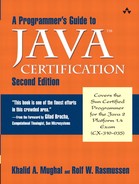3.11. Boolean Logical Operators: !, ^, &, |
Boolean logical operators include the unary operator ! (logical complement) and the binary operators & (logical AND), | (logical inclusive OR), and ^ (logical exclusive OR, a.k.a. logical XOR). Boolean logical operators can be applied to boolean operands, returning a boolean value. The operators &, |, and ^ can also be applied to integral operands to perform bitwise logical operations (see Section 3.13, p. 75).
Given that x and y represent boolean expressions, the boolean logical operators are defined in Table 3.9. In the table, the operators are ranked, with the operator having the highest precedence first.
These operators always evaluate both the operands, unlike their counterpart conditional operators && and || (see Section 3.12, p. 72). Truth-values for boolean logical operators are shown in Table 3.10.
| x | y | !x | x & y | x | y | x ^ y |
|---|---|---|---|---|---|
| true | true | false | true | true | false |
| true | false | false | false | true | true |
| false | true | true | false | true | true |
| false | false | true | false | false | false |
Operand Evaluation for Boolean Logical Operators
In evaluation of boolean expressions involving boolean logical AND, XOR, and OR operators, both the operands are evaluated. The order of operand evaluation is always from left to right.
if (i > 0 & i++ < 10) {/*...*/} // i will be incremented, regardless of value in i.
The binary boolean logical operators have precedence lower than arithmetic and relational operators, but higher than assignment, conditional AND, and OR operators (see Section 3.12, p. 72). This is illustrated in the following examples:
boolean b1, b2, b3 = false, b4 = false; b1 = 4 == 2 & 1 < 4; // false, evaluated as (b1 = ((4 == 2) & (1 < 4))) b2 = b1 | !(2.5 >= 8); // true b3 = b3 ^ b2; // true b4 = b4 | b1 & b2; // false
Order of evaluation is illustrated for the last example:
(b4 = (b4 | (b1 & b2))) ⇒ (b4 = (false | (b1 & b2))) ⇒ (b4 = (false | (false & b2))) ⇒ (b4 = (false | (false & true))) ⇒ (b4 = (false | false)) ⇒ (b4 = false)
Note that b2 was evaluated although, strictly speaking, it was not necessary. This behavior is guaranteed for boolean logical operators.
Boolean Logical Compound Assignment Operators: &=, ^=, |=
Compound assignment operators for the boolean logical operators are defined in Table 3.11. The left-hand operand must be a boolean variable, and the right-hand operand must be a boolean expression. An identity conversion is applied implicitly on assignment. These operators can also be applied to integral operands to perform bitwise compound assignments (see Section 3.13, p. 78).
| Expression: | Given b and a Are of Type Boolean, the Expression Is Evaluated as: |
|---|---|
| b &= a | b = (b & (a)) |
| b ^= a | b = (b ^ (a)) |
| b |= a | b = (b | (a)) |
Examples of Boolean Logical Compound Assignment
boolean b1 = false, b2 = false, b3 = false; b1 |= true; // true b2 ^= b1; // true b3 &= b1 | b2; // (1) false. b3 = (b3 & (b1 | b2)). b3 = b3 & b1 | b2; // (2) true. b3 = ((b3 & b1) | b2).
It is instructive to note how the assignments at (1) and (2) above are performed, giving different results for the same value of the operands.
